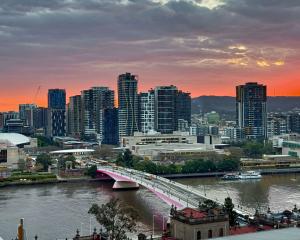Pam Jones is surrounded by literary heavyweights as she gets to know the city known as Nola.
Of all the proclamations and catchphrases, the paraphrasing and the claims, it was a southern belle called Blanche who uttered perhaps the most compelling declaration of love for that city of saints and sinners New Orleans.
"Don’t you just love those long rainy afternoons in New Orleans when an hour isn’t just an hour — but a little piece of eternity dropped into your hands — and who knows what to do with it?"
It wasn’t just about playwright Tennessee Williams’ observation of the women in Stanley Kowalski’s life in A Streetcar named Desire, or even about the sticky, sultry rain that falls so often in Nola (New Orleans, Louisiana).
It speaks of a deeper, determined love: a prolonged affair with a city Williams called his "spiritual home" and that allowed Williams — an avowed homosexual — to finally be himself.
"My life was a series of little adventures unconsummated before I was 28," he once told New York Times writer Mel Gussow.
"It was after I went to New Orleans that I selected homosexuality as a way of sexual life. Lucky for me, I made the decision ... The decision was made for me."
Williams, born Thomas Lanier Williams in Mississippi, did the bulk of his writing after he moved to New Orleans, aged 28.
It allowed a reinvention: he changed his name to Tennessee (possibly a college nickname, but also the state his father was from) and rededicated himself to writing, producing prolifically.
Many plays and poems eventuated, but it was A Streetcar named Desire that won him his first Pulitzer Prize and etched him into literary history.
It also honoured a romantic, rattly part of New Orleans life: Williams could see the Desire streetcar route from his New Orleans, St Peter St home, where he lived while he wrote the Pulitzer play.
Now the annual Tennessee Williams/New Orleans Literary Festival celebrates the writer’s creative genius each year — and allows fans to compete with bellows of Steeellllllllaaaaa!!! in a shouting contest that showcases the theatrical cry of the play.
It is but one of a host of literary events and inspiration that fill a city that has hosted a swag of writers: as well as Williams, William Faulkner, Ernest Hemingway, Mark Twain, Frances Parkinson Keyes, F. Scott Fitzgerald, John Kennedy Toole, Truman Capote, Ann Rice and John Grisham all had an association with Nola — whether resident or visitor — often weaving the city’s backdrop and stories into their written work.
Mark Twain, though associated more closely with rural Louisiana, said New Orleans’ Canal St was "finer, and more attractive and stirring than formerly, with its drifting crowds of people, its several processions of hurrying street cars, and — toward evening — its broad second-story verandas crowded with gentlemen and ladies clothed according to the latest mode".
Ann Rice — famous for her book Interview with a Vampire — spoke of her return to New Orleans in 1988 and said as soon as she "smelled the air, I knew I was home. It was rich, almost sweet, like the scent of jasmine and roses around our old courtyard. I walked the streets, savouring that long-lost perfume".
I myself noticed the scent of open gutters and sweaty revellers more, but New Orleans’ hold on those with a literary bent is undeniable.
On the long avenue that is bustling Canal St a statue of Ignatius Reilly stands at the entrance to the Hyatt French Quarter Hotel, immortalising the protagonist of John Kennedy Toole’s A Confederacy of Dunces.
Nearby, restaurants and hotels that provided variously safe harbour, liquor or ideas for generations of authors are living memorials to the conversations and thought processes of writers who drank, dined and slumbered there.
Antoine’s Restaurant on St Louis St was the setting for the murder mystery Dinner at Antoine’s by Frances Parkinson Keyes and is these days revered by foodies and book lovers alike.
The Hotel Monteleone, on Royal St, is one of only several hotels in the United States designated a literary landmark by the Friends of the Library Association, for its status as a centre of the literary elite; a window display of famous books penned there can be viewed by the public in the hotel’s foyer.
But for sheer class, visit Faulkner House Books at 624 Pirates Alley, around the corner from St Louis Cathedral and the rows of pavement artists selling their versions of New Orleans.
Nola has a lot that is grand and garish, but also much that is charming and tucked around corners.
Faulkner House Books falls into the dignified, hideaway category, the ground floor of the stylish two-storeyed house having been restored by owner Joe DeSalvo into a new and used book store that includes a collection of rare books by southern authors.
Faulkner wrote his first novel, Soldier’s Pay, in these rooms while living in the house in the 1920s during an era described as the height of French Quarter bohemia.
There are many other literary landmarks and events in this brave, brazen city, its heavy air laden with possibility and promise as street hawkers inject sass into one’s daily itinerary and buskers thrill with a blend of blues and jazz.
Jump right into it and invent your own writers’ tour around New Orleans — including a drink or two at one of its cafes, bars and restaurants — and create starring roles or cameos for Nola in your own recollections.
- Pam Jones travelled with the assistance of Hawaiian Airlines and IPW (International Pow Wow conference).















